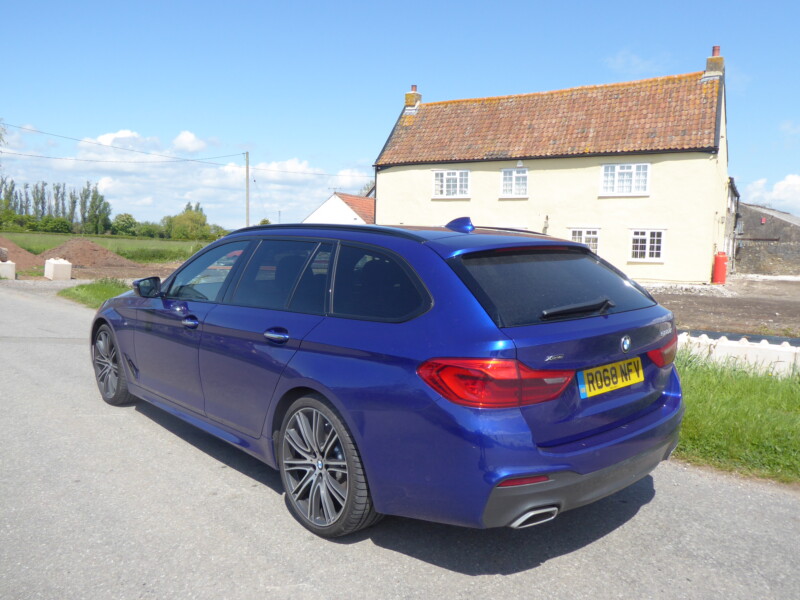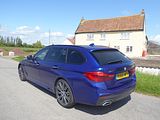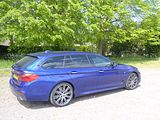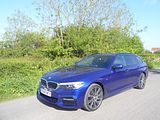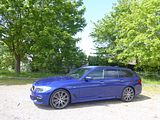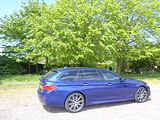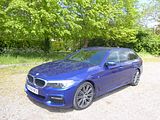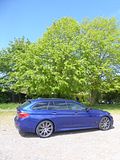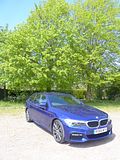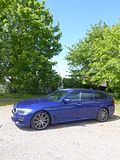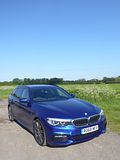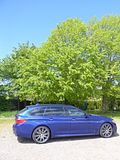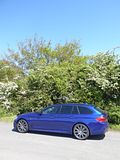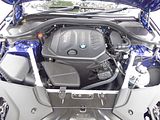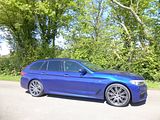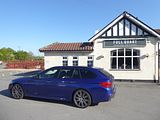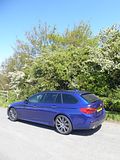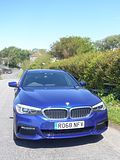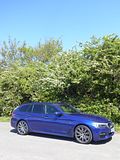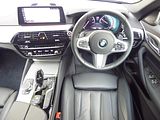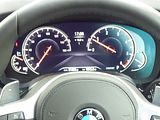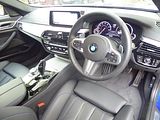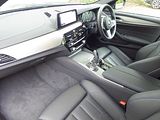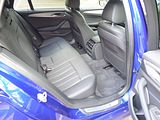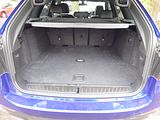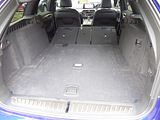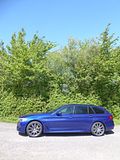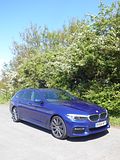Despite the seemingly unstoppable rise in sales of SUV and Crossover type vehicles, there is still a place for the traditional saloon and estate car in most segments of the market. And that includes what marketing types sometimes refer to as the E Segment, more meaningfully described as large executive cars. It is a segment that, in Europe at least, is completely dominated by the Germans, with the Audi A6 facing up to the BMW 5 Series and Mercedes E Class. Whilst there are alternatives from Jaguar, Volvo and Lexus, in Europe these sell in tiny numbers in comparison to the German cars these days. Although each of the three protagonists has their own take on what is expected of a large luxury car, the three match each other pretty closely in almost every way, with a choice of saloon and estate bodies, a wide variety of petrol and diesel engines, availability of all-wheel drive in some versions, a decent standard spec which can be augmented by spending in excess of a five figure sum on optional features, adoption of much of the latest tech and a reputation and loyalty that keeps sales strong. Each has their supporters who would take a lot of persuasion to “defect” to the other two marques, and with excellence a standard feature of all three, then perhaps that’s the only way you can choose between them. And indeed, each has a long history and pedigree stretching back over several decades. The BMW 5 Series first appeared in 1972, initially offered with a choice of a carb fed or fuel injected 2 litre engine, it quickly established a reputation for being good to drive and being well worth the hefty premium that it demanded over the established players such as the Ford Granada, Rover 2200 and Vauxhall Victor. Every six or seven years, BMW has given us a new 5 Series, with the result that the current model is the 7th generation to bear the badging. Launched in late 2016 and hitting the market early in 2017, the G30-generation, as the car is known in BMW development speak, was a considered and cautious evolution of its predecessor, offered with a wide choice of engines and a price span that goes from the relatively affordable two litre models to the potent M5 at well over double the cost. The motoring journalists loved it, especially the British press, saying that it was pretty well perfect in every regard and sales have been strong, with well over 300,000 examples being built every year. I’ve never been as besotted with BMWs as they are, often finding that the entry level cars, certainly in the 1 Series and 3 Series ranges to be quite obviously that and feeling like BMW wanted to you to feel you needed to go higher in the range to get to their sweet spot, in a way that the equivalent Audi does not make you think. The more expensive BMWs have always seemed pretty good though, as a recent experience in a 740i reminded me, so I was interested to know whether the 5 Series would come across as like a slightly smaller 7 or a slightly larger 3. The chance to find out came when I was given a 520d Touring as a loan car when my Maserati was in for a service. Painted in a rather appealing bright blue that BMW call Mediterranean Blue Metallic, this M Sport equipped version certainly looked good, with perhaps the best visual appeal of any current BMW model, but I needed to find out what the car was like to drive and to be in. Time to find out.
Despite the increasing hostility to diesel engines, they remain an important element of ranges such as the 5 Series, at least in Europe, and of the two different diesel models offered in the 5 Series, it is the less powerful 4 cylinder 520d that sells in greater quantities than its six cylinder 530d stablemate. BMW have continued to evolve and refine their diesel engines and what they have now is seriously impressive. Rather than the once characteristic rattly sound that you get when starting the engine from cold, now you get more of a rumble that reminds you of a V8, even though this 2 litre unit has but 4 cylinders. In this car it develops 188 bhp. All 5 Series cars now come with an eight speed ZF automatic gearbox. The refinement continues as you move off, with noise levels always low and the smoothness and refinement always in evidence. Whilst a 2 litre unit might not sound that much for a car of this size, in practice, it is more than adequate. The gearbox is well matched to the engine and the car always seemed to be in the right gear, allowing full advantage to be taken of the 295 lb/ft of torque, all of which is available at just 1750 rpm, so it was not really necessary to rev the engine hard to get a burst of acceleration. There are wheel-mounted paddles to enable you to change the gears yourself, but you would struggle to do it better than the car does for itself. Acceleration is smooth and the car feels surprisingly brisk considering its weight. Although I had this car for a couple of days, I did not do that many miles in it, and it came with part of a tank of fuel, so I could not really work out what the fuel economy was based on what fuel I put in it, but the car itself declared a result of 43.1 mpg, and in my experience what a car reports these days tends to be pretty accurate. The official figures are much better than this, with 65.1 mpg being quoted, and more importantly, and the reason why this version of the car is popular, the CO2 rating is an impressively low 109 g/km.
BMW may no longer use the “Ultimate Driving Machine” strap line in their advertising, but people still expect a BMW to be good to drive, with a sporty feel, even in a car that competes in a luxury segment as this 5 Series does. I’m not sure that what you get with this car is quite as sporting as you might expect, even though all the ingredients would seem to be there including 505-50 weight distribution and a suitably stiff chassis. The steering is light and does not have that much feel, which does make the car easy to manoeuvre but not necessarily as good to punt down a twisty road as say a Jaguar XF. This car had the optional xDrive all-wheel drive system, which would unquestionably come in useful in circumstances where grip is in short supply, which. as many have found, can be simply a wet grassy car park. I had no need for this during my tenure as it was dry and warm. Certainly the car felt composed on the bendy minor roads that I took the car on in quest of photos, cornering flat and with plenty of grip in evidence. I had no cause to test the ultimate stopping power of the brakes, but in normal use they were fine, with the car coming to a halt following only moderate pressure on the pedal. This all reads pretty well, but sadly there is a huge “but” that has to complete the on-the-road story, And this concerns the ride. Honestly, this was among the worst riding cars I have ever come across. The combination of the M-Sport suspension, low profile 20″ wheels and the extra stiff sidewalls that are a consequence of the run-flat tyres resulted in a set-up which was at best uncomfortable and at worst, totally unbearable. The car was sensitive to surfaces that have never troubled any other car I have ever driven, and once you found some of the worse parts of our road network, it jarred in a way that was most unpleasant. And this was the experience with the car in Comfort mode. Put it into Sport, and. as you might imagine, things got even worse. What is very strange is that having suffered this and been aghast at how awful it felt, I went online to see what the press had said when they had sampled the car. Amazingly, none of them seemed to have complained, and some even went as far as saying how well the car rode. Quite why they thought it was OK and I found it so bad that I could not live with it, I could not determine. Perhaps tellingly, you can order an M Sport car with the standard suspension of the SE, or you can pay extra for variable damper control, which apparently does improve things, but as sampled here, it was so bad that nothing would persuade me I could live with the car in this spec. Visibility is about as good as you get with modern cars, though the rear window is smaller than you might think, so the parking sensors really are invaluable.
There can be no question that you are in a BMW when you look at the interior, as the 520d Touring very much follows family style. It is mostly very well done. The plastic mouldings are of a high quality and soft to the touch, there is plenty of leather and the inlays of the test car were a sort of mottled metal effect that to my eyes looks better than some of the fake wood of carbon fibre styles you often see. The leather-wrapped steering wheel is very chunky, perhaps a touch too thick for my tastes, as is the BMW way. The instrument cluster contains two large electronic dials for speedo and rev counter with smaller fuel level and water temperature gauges set outside the larger ones. As with other BMWs, the odometer is in the middle, at the base of the cluster and with the seat and wheel set where I wanted them, I cannot read it whilst driving, which is always irksome. Thankfully, BMW abandoned the little-liked one touch stalks a while back so there are just rather chunky conventional ones for indicators ad wipers, whilst the lights are operated by a rotary dial on the dash to the right of the wheel. there are repeater buttons for the audio unit and also the cruise control settings on the steering wheel boss. The 8.7″ infotainment screen is mounted high, looking a bit like a sort of stuck-on tablet, though it does actually have a solid backing. It is touch sensitive, and responds to conversational speech but it is generally easier to control the functions using the iDrive control wheel and the buttons in the centre console. It is among the easiest such system to use and the latest version of iDrive allows the user to customise the menus. Navigation is standard as is DAB radio as part of the Harman Kardon audio system. The graphics on the unit are clear and the system was decently responsive. Beneath the screen is a rhomboid shaped air which contains the central air vents and then the buttons and knobs for the audio unit and the dual zone climate control system.
The test car featured leather upholstery, which from a distance looked good, but examined close-up, this was not as impressive as you might expect, being quite hard and feeling a bit on the thin side. In this segment of the market, Audi and Volvo still do the best interior quality. Some colour contrast is proved with blue stitching and small M Sport logos which you may or may not like. The front seat adjustment is a mix of manual and electric, with fore/aft done manually but height and backrest rake electrically. There is a wide range of adjustment in all directions and you can sit really quite low if you so desire. There is a pull-out bolster on the front of the seat cushions which those with long thigh ones would find useful. The steering column also moves from a wide arc up and down as well as in and out, so everyone should be able to get comfortable here, which was certainly the case for me. The seat itself seemed well shaped and I had no issues sitting here, though I did not have any particularly long journeys in the car. The 5 Series is a large car and so someone selecting this over a 3 Series would reasonably expect more space, especially for those in the rear seats and that is what you get with a few inches more legroom available. Even with the front seats set well back, there is sufficient space here. Headroom is plentiful, too. There is quite a sizeable central tunnel, though, and the centre console unit extends quite a long way back so whilst there is ample width for three people here, and the seats are not as obviously shaped for two as was the case with its predecessor, the fact remains that the middle seat occupant will not get as good a deal as those in the outer seats. There is a drop-down armrest which contains cup holders in the upper surface. There are map pockets in the back of the front seats and pockets on the doors for odds and ends. The reason for selecting a Touring model rather than the conventional saloon is for the load-carrying capacity and versatility, and this 5 Series does not disappoint here, though the ultimate carrying capacity is not quite as big as its main rivals. The load platform is flush with the base of the tailgate, so getting heavy and awkward things would be easy. The large and heavy tailgate opens and closes with electrical assistance. The available space is generous, with plenty of height under the load cover and a long platform back to the rear seats and there is a useful cubby under the main boot floor. More room can be created by dropping the rear seat backrests down. The resulting area is certainly long, though not quite flat, the seat backrests sloping up slightly, Inside the cabin there are the usual sorts of provisions for odds and ends: a decently-sized glovebox, pockets on the doors and a cubby under the central armrest and a bin over the driver’s right knee. There is an area in front of the gearlever, which can be used thanks to the high sides of the console which is actually the sliding lid to cover the cupholders.
Unlike most car ranges these days, BMW keep things simple with the 5 Series as you get a choice of just two trim levels, besides the M550i and M5 versions. SE cars come with a generous level of equipment which includes 18″ alloy wheels, LED front and rear lights, full leather upholstery, heated front seats, the iDrive-based infotainment including navigation and a DAB radio, connected-car services, and folding door mirrors. M Sport models have a redesigned front bumper, a sporty bodykit, M Sport badging, different alloy wheels, lowered suspension, upgraded interior trim details and sports seats. Of course, that is just the start, as there are lengthy lists of options and option packages available, as well as configuration choices on everything from colour of the paint and seat upholstery and dash inlays to the wheel design. You can, and probably will end up with quite a higher purchase price than the headline number, and will no doubt have been told by an eager sales person that much of this is essential for residual value purposes. Frankly, the SE is well equipped as standard and you probably don’t really need much else. Whilst the trim levels remain refreshingly simple, there is still an extensive range of models, as BMW currently offer the 5 Series in the UK with a choice of 5 petrol engines and 2 diesels. Petrol models start with the 520i, which puts out 184 bhp from its 4 cylinder 2 litre engine. The same unit features in the 530i, whilst those who crave more cylinders will need to look at the 540i or the full-fat M5. There is also a 530e with a tax efficient plug-in hybrid engine. The two diesels are the 4 cylinder 520d as tested and the more potent, but thirstier 6 cylinder 530d. With the exception of the M5, the Touring body is available with the same engines as the regular Saloon.
There was much to like about this 520d Touring. It drove well, with ample performance and was super smooth and quiet underway and was decently economical. The interior is nicely finished and there is plenty of space for people and luggage. But I absolutely could not own this car in the spec as supplied. The ride was so terrible that this car would be an absolute nightmare on a daily basis, with that combination of the run- flat tyres and the hard M-Sport suspension making the car uncomfortable in the extreme. Change this, potentially by choosing an SE model, and I suspect also putting on less stiff tyres, and the car might well be among the best in class, but with these fitted, I can’t see how anyone could put up with it. What a shame.

